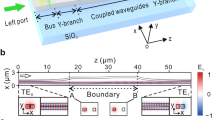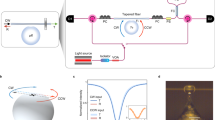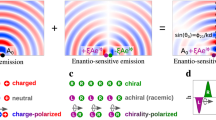Abstract
Electromagnetically induced transparency, as a quantum interference effect to eliminate optical absorption in an opaque medium, has found extensive applications in slow-light generation, optical storage, frequency conversion, optical quantum memory and enhanced nonlinear interactions at the few-photon level in all kinds of systems. Recently, there has been great interest in exceptional points, a type of spectral singularity that could be reached by tuning various parameters in open systems, to render unusual features to the physical systems, such as optical states with chirality. Here we theoretically and experimentally study transparency and absorption modulated by chiral optical states at exceptional points in an indirectly coupled resonator system. By tuning one resonator to an exceptional point, transparency or absorption occurs depending on the chirality of the eigenstate. Our results demonstrate a new strategy to manipulate the light flow and the spectra of a photonic resonator system by exploiting a discrete optical state associated with a specific chirality at an exceptional point as a unique control bit. Such an approach is compatible with the state control utilized in quantum gate operation and may open up new avenues for controlling slow light using optical states for optical quantum memory and computing.
This is a preview of subscription content, access via your institution
Access options
Access Nature and 54 other Nature Portfolio journals
Get Nature+, our best-value online-access subscription
$29.99 / 30 days
cancel any time
Subscribe to this journal
Receive 12 print issues and online access
$209.00 per year
only $17.42 per issue
Buy this article
- Purchase on Springer Link
- Instant access to full article PDF
Prices may be subject to local taxes which are calculated during checkout




Similar content being viewed by others
References
Fleischhauer, M., Imamoglu, A. & Marangos, J. P. Electromagnetically induced transparency: optics in coherent media. Rev. Mod. Phys. 77, 633–673 (2005).
Project, P. et al. Nonlinear optical processes using electromagnetically induced transparency. Phys. Rev. Lett. 64, 1107–1110 (1990).
Boller, K. J., Imamoğlu, A. & Harris, S. E. Observation of electromagnetically induced transparency. Phys. Rev. Lett. 66, 2593–2596 (1991).
Akulshin, A. M., Barreiro, S. & Lezama, A. Electromagnetically induced absorption and transparency due to resonant two-field excitation of quasidegenerate levels in Rb vapor. Phys. Rev. A 57, 2996–3002 (1998).
Röhlsberger, R., Wille, H.-C., Schlage, K. & Sahoo, B. Electromagnetically induced transparency with resonant nuclei in a cavity. Nature 482, 199–203 (2012).
Mücke, M. et al. Electromagnetically induced transparency with single atoms in a cavity. Nature 465, 755–758 (2010).
Papasimakis, N., Fedotov, V. A., Prosvirnin, S. L. & Zheludev, N. I. A metamaterial analog of electromagnetically induced transparency. Phys. Rev. Lett. 101, 253903 (2008).
Jain, A. et al. Electromagnetically induced transparency and absorption in metamaterials: the radiating two-oscillator model and its experimental confirmation. Phys. Rev. Lett. 109, 187401 (2012).
Liu, N. et al. Plasmonic analogue of electromagnetically induced transparency at the Drude damping limit. Nat. Mater. 8, 758–762 (2009).
Taubert, R., Hentschel, M., Kästel, J. & Giessen, H. Classical analog of electromagnetically induced absorption in plasmonics. Nano Lett. 12, 1367–1371 (2012).
Dyer, G. C. et al. Induced transparency by coupling of Tamm and defect states in tunable terahertz plasmonic crystals. Nat. Photon. 7, 925–930 (2013).
Hsu, C. W., DeLacy, B. G., Johnson, S. G., Joannopoulos, J. D. & Soljacic, M. Theoretical criteria for scattering dark states in nanostructured particles. Nano Lett. 14, 2783–2788 (2014).
Xu, Q. et al. Experimental realization of an on-chip all-optical analogue to electromagnetically induced transparency. Phys. Rev. Lett. 96, 123901 (2006).
Xu, Q., Dong, P. & Lipson, M. Breaking the delay-bandwidth limit in a photonic structure. Nat. Phys. 3, 406–410 (2007).
Limonov, M. F., Rybin, M. V., Poddubny, A. N. & Kivshar, Y. S. Fano resonances in photonics. Nat. Photon. 11, 543–554 (2017).
Weis, S. et al. Optomechanically induced transparency. Science 330, 1515–1520 (2010).
Safavi-Naeini, A. H. et al. Electromagnetically induced transparency and slow light with optomechanics. Nature 472, 69–73 (2011).
Lü, H., Wang, C., Yang, L. & Jing, H. Optomechanically induced transparency at exceptional points. Phys. Rev. Appl. 10, 14006 (2018).
Anisimov, P. M., Dowling, J. P. & Sanders, B. C. Objectively discerning Autler-Townes splitting from electromagnetically induced transparency. Phys. Rev. Lett. 107, 163604 (2011).
Abdumalikov, A. A. et al. Electromagnetically induced transparency on a single artificial atom. Phys. Rev. Lett. 104, 193601 (2010).
Veldhorst, M. et al. A two-qubit logic gate in silicon. Nature 526, 410–414 (2015).
Li, X. et al. An all-optical quantum gate in a semiconductor quantum dot. Science 301, 809–811 (2003).
Pang, M., He, W., Jiang, X. & Russell, P. S. J. All-optical bit storage in a fibre laser by optomechanically bound states of solitons. Nat. Photon. 10, 454–458 (2016).
Wu, B. et al. Slow light on a chip via atomic quantum state control. Nat. Photon. 4, 776–779 (2010).
Peng, B. et al. Chiral modes and directional lasing at exceptional points. Proc. Natl Acad. Sci. USA 113, 6845–6850 (2016).
Miao, P. et al. Orbital angular momentum microlaser. Science 353, 464–467 (2016).
Cao, H. & Wiersig, J. Dielectric microcavities: model systems for wave chaos and non-Hermitian physics. Rev. Mod. Phys. 87, 61–111 (2015).
El-Ganainy, R. et al. Non-Hermitian physics and PT symmetry. Nat. Phys. 14, 11–19 (2018).
Feng, L., El-Ganainy, R. & Ge, L. Non-Hermitian photonics based on parity–time symmetry. Nat. Photon. 11, 752–762 (2017).
Miri, M.-A. & Alù, A. Exceptional points in optics and photonics. Science 363, eaar7709 (2019).
Feng, L. et al. Experimental demonstration of a unidirectional reflectionless parity-time metamaterial at optical frequencies. Nat. Mater. 12, 108–113 (2013).
Chen, W., Kaya Özdemir, Ş., Zhao, G., Wiersig, J. & Yang, L. Exceptional points enhance sensing in an optical microcavity. Nature 548, 192–196 (2017).
Hodaei, H. et al. Enhanced sensitivity at higher-order exceptional points. Nature 548, 187–191 (2017).
Xu, H., Mason, D., Jiang, L. & Harris, J. G. E. Topological energy transfer in an optomechanical system with exceptional points. Nature 537, 80–83 (2016).
Hahn, C. et al. Time-asymmetric loop around an exceptional point over the full optical communications band. Nature 562, 86–90 (2018).
Zhang, J. et al. A phonon laser operating at an exceptional point. Nat. Photon. 12, 479–484 (2018).
Wong, Z. J. et al. Lasing and anti-lasing in a single cavity. Nat. Photon. 10, 796–801 (2016).
Zhao, H. et al. Metawaveguide for asymmetric interferometric light–light switching. Phys. Rev. Lett. 117, 193901 (2016).
Peng, B. et al. Parity–time-symmetric whispering-gallery microcavities. Nat. Phys. 10, 394–398 (2014).
Peng, B. et al. Loss-induced suppression and revival of lasing. Science 346, 328–332 (2014).
Liu, Y.-C., Li, B.-B. & Xiao, Y.-F. Electromagnetically induced transparency in optical microcavities. Nanophotonics 6, 789–811 (2017).
Ruan, Z. & Fan, S. Superscattering of light from subwavelength nanostructures. Phys. Rev. Lett. 105, 013901 (2010).
Verslegers, L., Yu, Z., Ruan, Z., Catrysse, P. B. & Fan, S. From electromagnetically induced transparency to superscattering with a single structure: a coupled-mode theory for doubly resonant structures. Phys. Rev. Lett. 108, 083902 (2012).
Qian, C. et al. Experimental observation of superscattering. Phys. Rev. Lett. 122, 063901 (2019).
Lezama, A., Barreiro, S. & Akulshin, A. M. Electromagnetically induced absorption. Phys. Rev. A 59, 4732–4735 (1999).
Taichenachev, A. V., Tumaikin, A. M. & Yudin, V. I. Electromagnetically induced absorption in a four-state system. Phys. Rev. A 61, 011802 (1999).
Zhang, M. et al. Broadband electro-optic frequency comb generation in an integrated microring resonator. Nature 568, 373–377 (2018).
Wang, C. et al. Integrated lithium niobate electro-optic modulators operating at CMOS-compatible voltages. Nature 562, 101–104 (2018).
Zhu, J., Özdemir, Ş. K., He, L. & Yang, L. Controlled manipulation of mode splitting in an optical microcavity by two Rayleigh scatterers. Opt. Express 18, 23535–23543 (2010).
Zhu, J. et al. On-chip single nanoparticle detection and sizing by mode splitting in an ultrahigh-Q microresonator. Nat. Photon. 4, 46–49 (2010).
Acknowledgements
This work was supported by NSF grant no. EFMA1641109, ARO grant no. W911NF1710189 and DARPA under grant HR00111820042. A.D.S. acknowledges the support of NSF grant no. DMR-1743235. L.J. acknowledges the support of the Packard Foundation (2013-39273).
Author information
Authors and Affiliations
Contributions
X.J., C.W. and L.Y. conceived the idea and designed the experiments. C.W. and X.J. performed the experiments with help from G.Z. and B.P. C.W. analysed experimental data with help from X.J. and M.Z. Theoretical background and simulations were provided by C.W. with help from M.Z., C.W.H., L.J. and A.D.S. All authors discussed the results and wrote the manuscript. L.Y. supervised the project.
Corresponding author
Ethics declarations
Competing interests
The authors declare no competing interests.
Additional information
Publisher’s note Springer Nature remains neutral with regard to jurisdictional claims in published maps and institutional affiliations.
Supplementary information
Supplementary Information
Supplementary discussion.
Supplementary Data 1
The data corresponding to the graphs in Fig 1.
Supplementary Data 2
The data corresponding to the graphs in Fig 2.
Supplementary Data 3
The data corresponding to the graphs in Fig 3.
Supplementary Data 4
The data corresponding to the graphs in Fig 4.
Rights and permissions
About this article
Cite this article
Wang, C., Jiang, X., Zhao, G. et al. Electromagnetically induced transparency at a chiral exceptional point. Nat. Phys. 16, 334–340 (2020). https://doi.org/10.1038/s41567-019-0746-7
Received:
Accepted:
Published:
Issue Date:
DOI: https://doi.org/10.1038/s41567-019-0746-7
This article is cited by
-
Non-orthogonal cavity modes near exceptional points in the far field
Communications Physics (2024)
-
Coherent control of chaotic optical microcavity with reflectionless scattering modes
Nature Physics (2024)
-
Creating pairs of exceptional points for arbitrary polarization control: asymmetric vectorial wavefront modulation
Nature Communications (2024)
-
Controllable transparency and slow–fast light in an optomechanical system with a triple quantum well
Optical and Quantum Electronics (2024)
-
Manipulating light transmission and absorption via an achromatic reflectionless metasurface
PhotoniX (2023)



